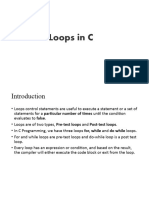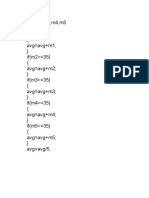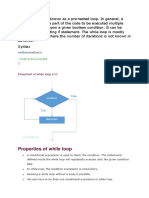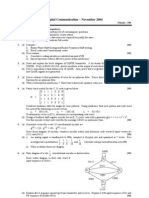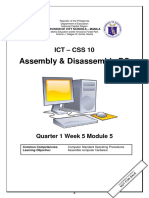EXERCISE 5
Content:
1. C Loops
2. C do-while loop
3. C while loop
4. C for loop
I. C Loops
The looping can be defined as repeating the same process multiple times until
a specific condition satisfies. There are three types of loops used in the C
language.
Why use loops in C language?
The looping simplifies the complex problems into the easy ones. It enables us
to alter the flow of the program so that instead of writing the same code again
and again, we can repeat the same code for a finite number of times. For
example, if we need to print the first 10 natural numbers then, instead of
using the printf statement 10 times, we can print inside a loop which runs up
to 10 iterations.
Advantage of loops in C
1) It provides code reusability.
2) Using loops, we do not need to write the same code again and again.
3) Using loops, we can traverse over the elements of data structures (array
or linked lists).
Types of C Loops
There are three types of loops in C language that is given below:
1. do while
2. while
3. for
II. C do-while loop
The do while loop is a post tested loop. Using the do-while loop, we can repeat
the execution of several parts of the statements. The do-while loop is mainly
used in the case where we need to execute the loop at least once. The do-
while loop is mostly used in menu-driven programs where the termination
condition depends upon the end user.
1
�do while loop syntax
The syntax of the C language do-while loop is given below:
do{
//code to be executed
}while(condition);
IMPORTANT: Now we will change the online compiler CodeChef with this one:
https://www.onlinegdb.com/online_c_compiler
LAB: Type the following code and press RUN button:
Result/Output:
2
�Flowchart of do while loop:
LAB: Simple program of do while loop where we are printing the table of 1.
Result/Output:
3
�LAB: Program to print table for the given number using do while loop
Result/Output:
Infinitive do while loop
The do-while loop will run infinite times if we pass any non-zero value as the
conditional expression.
do{
//statement
}while(1);
4
� III. C while loop
While loop is also known as a pre-tested loop. In general, a while loop allows
a part of the code to be executed multiple times depending upon a given
boolean condition. It can be viewed as a repeating if statement. The while loop
is mostly used in the case where the number of iterations is not known in
advance.
The syntax of while loop in c language is given below:
while(condition){
//code to be executed
}
Flowchart of while loop in C:
LAB: Simple program of while loop that prints table of 1.
5
�Result/Output:
LAB: Program to print table for the given number using while loop in C:
Result/Output:
6
�Properties of while loop
A conditional expression is used to check the condition. The statements
defined inside the while loop will repeatedly execute until the given
condition fails.
The condition will be true if it returns 0. The condition will be false if it
returns any non-zero number.
In while loop, the condition expression is compulsory.
Running a while loop without a body is possible.
We can have more than one conditional expression in while loop.
If the loop body contains only one statement, then the braces are
optional.
LAB: See the following example:
Result/Output:
Infinitive while loop in C
If the expression passed in while loop results in any non-zero value then the
loop will run the infinite number of times.
while(1){
//statement
}
7
� IV. C for loop
The for loop in C language is used to iterate the statements or a part of the
program several times. It is frequently used to traverse the data structures
like the array and linked list.
The syntax of for loop in c language is given below:
for(Expression 1; Expression 2; Expression 3){
//code to be executed
}
Flowchart of for loop in C:
LAB: Simple program of for loop that prints table of 1.
8
�Result/Output:
LAB: Print table for the given number using C for loop
Result/Output:
9
�Properties of Expression 1
The expression represents the initialization of the loop variable.
We can initialize more than one variable in Expression 1.
Expression 1 is optional.
In C, we can not declare the variables in Expression 1. However, It can
be an exception in some compilers.
LAB: Example 1:
LAB: Example 2:
10
�Properties of Expression 2
Expression 2 is a conditional expression. It checks for a specific condition
to be satisfied. If it is not, the loop is terminated.
Expression 2 can have more than one condition. However, the loop will
iterate until the last condition becomes false. Other conditions will be
treated as statements.
Expression 2 is optional.
Expression 2 can perform the task of expression 1 and expression 3.
That is, we can initialize the variable as well as update the loop variable
in expression 2 itself.
We can pass zero or non-zero value in expression 2. However, in C, any
non-zero value is true, and zero is false by default.
LAB: Example 1:
11
�LAB: Example 2:
Properties of Expression 3
Expression 3 is used to update the loop variable.
We can update more than one variable at the same time.
Expression 3 is optional.
LAB: Example 1:
12
�Loop body
The braces {} are used to define the scope of the loop. However, if the loop
contains only one statement, then we don't need to use braces. A loop without
a body is possible. The braces work as a block separator, i.e., the value
variable declared inside for loop is valid only for that block and not outside.
Consider the following example.
Infinitive for loop in C
To make a for loop infinite, we need not give any expression in the syntax.
Instead of that, we need to provide two semicolons to validate the syntax of
the for loop. This will work as an infinite for loop.
13
�If you run this program, you will see above statement infinite times.
14














